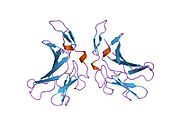Insulin-like growth factor 2 receptor
Ensembl | |||||||||
|---|---|---|---|---|---|---|---|---|---|
| UniProt | |||||||||
| RefSeq (mRNA) | |||||||||
| RefSeq (protein) | |||||||||
| Location (UCSC) | Chr 6: 159.97 – 160.11 Mb | Chr 17: 12.9 – 12.99 Mb | |||||||
| PubMed search | [3] | [4] | |||||||
| View/Edit Human | View/Edit Mouse |
Insulin-like growth factor 2 receptor (IGF2R), also called the cation-independent mannose-6-phosphate receptor (CI-MPR) is a
Structure
The structure of the IGF2R is a
Function
IGF2R functions to clear IGF2 from the cell surface to attenuate signalling, and to transport lysosomal
Interactions
Insulin-like growth factor 2 receptor has been shown to
Evolution
The insulin-like growth factor 2 receptor function evolved from the cation-independent mannose 6-phosphate receptor and is first seen in Monotremes. The IGF-2 binding site was likely acquired fortuitously with the generation of an exonic splice site enhancer cluster in exon 34, presumably necessitated by several kilobases of repeat element insertions in the preceding intron. A six-fold affinity maturation then followed during therian evolution, coincident with the onset of imprinting and consistent with the theory of parental conflict.[11]
See also
- Cluster of differentiation
- IGF-1 Receptor
- Mannose 6-phosphate receptor
References
- ^ a b c GRCh38: Ensembl release 89: ENSG00000197081 – Ensembl, May 2017
- ^ a b c GRCm38: Ensembl release 89: ENSMUSG00000023830 – Ensembl, May 2017
- ^ "Human PubMed Reference:". National Center for Biotechnology Information, U.S. National Library of Medicine.
- ^ "Mouse PubMed Reference:". National Center for Biotechnology Information, U.S. National Library of Medicine.
- PMID 2963003.
- ^ PMID 2852162.
- ^ S2CID 16991464.
- PMID 15511083.
- S2CID 17161071.
- PMID 10908666.
- PMID 23197533.
Further reading
- O'Dell SD, Day IN (1998). "Insulin-like growth factor II (IGF-II)". Int. J. Biochem. Cell Biol. 30 (7): 767–71. PMID 9722981.
- Hawkes C, Kar S (2004). "The insulin-like growth factor-II/mannose-6-phosphate receptor: structure, distribution and function in the central nervous system". Brain Res. Brain Res. Rev. 44 (2–3): 117–40. S2CID 20434586.
- Scott CD, Firth SM (2005). "The role of the M6P/IGF-II receptor in cancer: tumor suppression or garbage disposal?". Horm. Metab. Res. 36 (5): 261–71. S2CID 260166901.
- Antoniades HN, Galanopoulos T, Neville-Golden J, Maxwell M (1992). "Expression of insulin-like growth factors I and II and their receptor mRNAs in primary human astrocytomas and meningiomas; in vivo studies using in situ hybridization and immunocytochemistry". Int. J. Cancer. 50 (2): 215–22. S2CID 22632952.
- Zhou J, Bondy C (1992). "Insulin-like growth factor-II and its binding proteins in placental development". Endocrinology. 131 (3): 1230–40. PMID 1380437.
- Morgan DO, Edman JC, Standring DN, Fried VA, Smith MC, Roth RA, Rutter WJ (1987). "Insulin-like growth factor II receptor as a multifunctional binding protein". Nature. 329 (6137): 301–7. S2CID 4308631.
- Oshima A, Nolan CM, Kyle JW, Grubb JH, Sly WS (1988). "The human cation-independent mannose 6-phosphate receptor. Cloning and sequence of the full-length cDNA and expression of functional receptor in COS cells". J. Biol. Chem. 263 (5): 2553–62. PMID 2963003.
- De Souza AT, Hankins GR, Washington MK, Orton TC, Jirtle RL (1996). "M6P/IGF2R gene is mutated in human hepatocellular carcinomas with loss of heterozygosity". Nat. Genet. 11 (4): 447–9. S2CID 21787312.
- Ilvesmäki V, Blum WF, Voutilainen R (1994). "Insulin-like growth factor binding proteins in the human adrenal gland". Mol. Cell. Endocrinol. 97 (1–2): 71–9. S2CID 22503525.
- De Souza AT, Hankins GR, Washington MK, Fine RL, Orton TC, Jirtle RL (1995). "Frequent loss of heterozygosity on 6q at the mannose 6-phosphate/insulin-like growth factor II receptor locus in human hepatocellular tumors". Oncogene. 10 (9): 1725–9. PMID 7753549.
- Schmidt B, Kiecke-Siemsen C, Waheed A, Braulke T, von Figura K (1995). "Localization of the insulin-like growth factor II binding site to amino acids 1508-1566 in repeat 11 of the mannose 6-phosphate/insulin-like growth factor II receptor". J. Biol. Chem. 270 (25): 14975–82. PMID 7797478.
- Rao PH, Murty VV, Gaidano G, Hauptschein R, Dalla-Favera R, Chaganti RS (1994). "Subregional mapping of 8 single copy loci to chromosome 6 by fluorescence in situ hybridization". Cytogenet. Cell Genet. 66 (4): 272–3. PMID 8162705.
- Ishiwata T, Bergmann U, Kornmann M, Lopez M, Beger HG, Korc M (1997). "Altered expression of insulin-like growth factor II receptor in human pancreatic cancer". Pancreas. 15 (4): 367–73. S2CID 42073680.
- Tikkanen R, Peltola M, Oinonen C, Rouvinen J, Peltonen L (1998). "Several cooperating binding sites mediate the interaction of a lysosomal enzyme with phosphotransferase". EMBO J. 16 (22): 6684–93. PMID 9362483.
- Nykjaer A, Christensen EI, Vorum H, Hager H, Petersen CM, Røigaard H, Min HY, Vilhardt F, Møller LB, Kornfeld S, Gliemann J (1998). "Mannose 6-Phosphate/Insulin-like Growth Factor–II Receptor Targets the Urokinase Receptor to Lysosomes via a Novel Binding Interaction". J. Cell Biol. 141 (3): 815–28. PMID 9566979.
- Díaz E, Pfeffer SR (1998). "TIP47: a cargo selection device for mannose 6-phosphate receptor trafficking". Cell. 93 (3): 433–43. S2CID 17161071.
- Wan L, Molloy SS, Thomas L, Liu G, Xiang Y, Rybak SL, Thomas G (1998). "PACS-1 defines a novel gene family of cytosolic sorting proteins required for trans-Golgi network localization". Cell. 94 (2): 205–16. S2CID 15027198.
- Killian JK, Jirtle RL (1999). "Genomic structure of the human M6P/IGF2 receptor". Mamm. Genome. 10 (1): 74–7. S2CID 20181915.
- Kumar S, Hand AT, Connor JR, Dodds RA, Ryan PJ, Trill JJ, Fisher SM, Nuttall ME, Lipshutz DB, Zou C, Hwang SM, Votta BJ, James IE, Rieman DJ, Gowen M, Lee JC (1999). "Identification and cloning of a connective tissue growth factor-like cDNA from human osteoblasts encoding a novel regulator of osteoblast functions". J. Biol. Chem. 274 (24): 17123–31. PMID 10358067.
External links
- Insulin-Like-Growth-Factor+II+Receptor at the U.S. National Library of Medicine Medical Subject Headings (MeSH)





